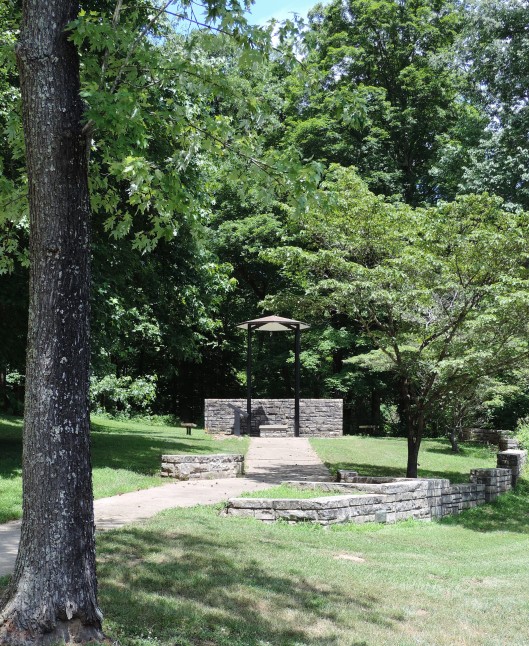Tags
- Adventure #9-The Trail of Tears National Historic Trail
- Destination #2-Bollinger Mill State Historic Site
- Destination #3-Trail of Tears State Park
In my last blog, posted on May 31, 2016, I introduced readers to the Trail of Tears National Historic Trail. The trail was established in 1987, as a memorial to the suffering of so many Native Americans when they were forcibly removed from their homes in the East to Indian Country, the area we now call Oklahoma. The trail runs through our home state of Missouri, from the Mississippi River in eastern Missouri to the Missouri-Arkansas border on the far western side of the state. We can actually walk in their footsteps, over the same paths they traveled. The trail serves as a reminder of a sad chapter in American history…one the likes of which we can never repeat.
Our next stops take us to Bollinger Mill State Historic Site and Trail of Tears State Park, both of which are on the Trail of Tears, as we continue to visit the National Park sites in “our own backyard”.
Bollinger Mill State Historic Site
In 1800, a man named George Bollinger moved, with a large group of his relatives, from North Carolina to a spot on the Whitewater River in southeastern Missouri. Bollinger built a mill on the site, while the twenty other families in the group built farms along the Whitewater, the Little Whitewater, and the Castor Rivers.
Over the years, a total of three mills have stood at the site. During the Civil War, the mill was burned by the Union Army to prevent the Confederates from obtaining flour or meal from its operation. Following the war, the mill was rebuilt with brick on top of the stone foundation that had survived the fire. Bollinger Mill went out of business in 1953.
When the Cherokee people were moved through the area, the disbursing agent, John Reynolds, purchased supplies at Bollinger’s Mill. In front of the mill, in the picnic area, you will find an interpretive sign showing copies of receipts itemizing those purchases.
Next to the mill you will see the Burfordville Covered Bridge. It was built in 1858, and is the oldest of only four covered bridges that still remain in Missouri today. It is 140 feet long and spans the Whitewater River.
If you visit the mill today, you will find displays that explain the work of the mill during its many years of operation. You can walk across the bridge, which is now closed to motor vehicles. While walking across the bridge, see if you can find the plastic owl mounted on the ceiling. My husband and I are still wondering why it is there. And when you are done seeing the sites, you can enjoy a pleasant, and peaceful picnic lunch in a beautiful grove of trees along the water’s edge.
To learn more about the mill and the covered bridge, visit their website http://www.mostateparks.com/park/bollinger-mill-state-historic-site.
Trail of Tears State Park
We visited Trail of Tears State Park, just north of Jackson, Missouri, on a beautiful, sun-drenched day in June. It was cooler than a typical summer day in Missouri, so we took a few short walks enjoying the bird song and the summer flora in the park.
But Trail of Tears is also a haunting reminder of the tragic journey of the Civilized Tribes. Just across from the park, on the Illinois side of the Mississippi River is one of the two places the Trail of Tears entered the river to cross into Missouri on the way west to Indian Country.
The Visitor Center has displays about the Trail of Tears and an informative movie on what it was, and why it happened. It is the same movie we saw at Meramec Spring Park, but it was certainly worth a second viewing.

After crossing the Mississippi River, some of the Cherokees camped at Moccasin Springs, which is in Trail of Tears State Park, as depicted in this display in the Visitor Center.
A boardwalk takes you to a beautiful view of the Mississippi, and a look back into history.
As we were leaving the park, we visited the Bushyhead Memorial. When ice began to mount up on the river, the crossings were halted for a time. Those who had already crossed, camped in the December cold, waiting for the remainder of their group to join them. They were under the leadership of Reverend Jesse Bushyhead. His sister, Nancy Bushyhead Walker Hildebrand, died during that cold winter, and she was buried in the park. The memorial was placed in the park to honor her life, as well as the lives of all the Cherokee who lost their lives along the Trail of Tears.
Our National Parks are a national treasure. We find in them relaxation, renewal, a call to nature, and sometimes we are called to recall our national history…the good and the bad, the joyous and the tragic. The Trail of Tears National Historic Trail is one of those park sites that should make us stop and think, to reflect on some of our past that is not so heroic, not so commendable. But in so doing, we should not despair, but we should look forward, and pledge to do better, to learn from our mistakes, to become a better people, to make this an even better nation.
You can learn more about Trail of Tears State Park at their website, http://www.mostateparks.com/park/trail-tears-state-park.
Cherokee Brown Bean Bread
I found this bean bread on a site that featured Cherokee Indian recipes, and adapted it slightly. It is delicious, and makes a perfect meal when served with a big fresh salad, a big pat of butter, and a glass of white wine. Enjoy!
Cherokee Brown Bean Bread
- 1 cup cornmeal
- 1 cup flour
- 2 tsp. baking powder
- 1 Tbsp. sugar
- 2 cups whole milk
- 1 cup melted shortening
- 1 beaten egg
- 2 Tbsp. honey
- 2-15 oz. cans pinto beans
Preheat your oven to 450 degrees, and put a greased cast iron frying pan in to get it nice and hot.
Drain all the liquid off the beans.
Mix all the ingredients except the beans thoroughly. Fold in the drained beans.
Pour into the hot skillet and bake for about 30 minutes, until golden brown, and a toothpick inserted in the center comes out clean.
Enjoy!












